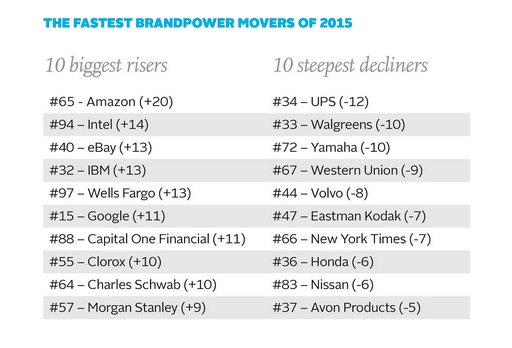
Apart from highlighting several brands that have made big gains, our recent report on this year’s most powerful brands made it clear that outperforming brands do two things very well. First, they keep customers aware of the brand by remaining relevant in an ever-changing market. Second, these organizations are able to evolve easily over time and improve their brand perception by consistently delivering positive and innovative customer experiences.
By studying the top movers from afar, other important themes emerge:
- The top-rising brands achieve strategic alignment between business strategy, brand innovation and marketing.
- Leadership teams at these companies create brand clarity through their communications to consumers, employees and investors.
- Top performers build competitive advantage by delivering consistent, valued results for customers over time.

Achieving Strategic Alignment: Amazon Stays Fresh
The best predictor of brand value creation is how effectively a company connects the brand to its business strategy. A company should have a unique value proposition, a distinctive and integrative value chain, clear guardrails on what it will and won’t do and an unwavering commitment consistent delivery over time.
Amazon has demonstrated it is an organization built to live and thrive in today’s fast moving environment. Built on a strategic vision to be the most customer-centric company on earth, time and again the company has proven its ability to reorient its product offerings and overall business model to meet and exceed consumers’ expectations. Over the years, a steady flow of brand innovations has kept Amazon at the forefront of digital retailing as well as ecommerce services. Most importantly, it is a brand that customers depend upon. Prime Membership, Amazon Web Services, and the newly launched Dash Button are a few great examples of how Amazon creates innovations that embody the brand in unexpected and novel ways.
SEE ALSO: How Big Brands Foster Global – Yet Regional – Loyalty and Awareness
In this context, it’s easy to see the role of a brand strategy focused on articulating the value proposition and shaping the actions required to deliver value to customers. To create customer experiences that embody the brand, it’s essential for marketers to understand the attributes and activities that comprise the business strategy.
Today’s business reality is centered on forging new relationships across marketing, IT, HR and operations, which traditionally functioned as siloed activities. Driving the brand across so many touch points and processes requires that the business strategy, company vision, mission and an organization’s purpose must be in total alignment. Marketers must build new relationships and rally resources across the organization.
Creating Brand Clarity: G is for Google
Google is ubiquitous – the Kleenex of web search and so much more. The brand is a wonderful study in how to take a category and innovating to create a vibrant enterprise. When you look at the portfolio in aggregate, Google is a wonderful ecosystem of products and services. Search, Maps, Gmail, YouTube, Drive, Chrome, and Android are examples of connected actives that Google built around its customers, to solidify its brand globally.
In recent years, the company has stretched into spaces that are not quite as “Googly.” To sustain its momentum, the founders believed the company needed to shake it up and break new ground. Autonomous cars, energy, life sciences and a myriad of other emerging ventures are coming onto the field of play. Google co-founder Larry Page realized that the businesses they were entering did not fit with the core business. The new ventures were causing Google to lose its focus, making investors nervous. To get ahead of any emerging problems, Google’s rebranding and newly minted holding company Alphabet is meant to create brand clarity and operational efficiency.

Google’s strategy has been articulated with great clarity. In the world of corporate branding, this is exciting. Why? Because Google’s leaders understand the ingredients of their success, the core of their brands, and their vision of the future. It’s a future they know will go well beyond the brand permissions that they have today.
Google’s letter to investors and employees is a wonderful example of how to be clear about your strategic intent, creating a flexible platform to drive future brand innovation.
The Alphabet move is smart and the rebranding of Google gets high marks. To drive future growth, this part of the company needs to be isolated and “slimmed down” to create clarity for its employees, customers and investors. This kind of clarity gives the Google brand focus and opens the door for other big brands to be built. Lesson learned? Clarity enables brands to do more and be better.
RELATED: How to Build a Better Customer Experience in the Internet of Things
Delivering Consistent Results: Wells Fargo Puts Customers First
Brand managers can easily become overwhelmed in the pursuit of improved customer experiences. Trying to do everything, be everything and “wow” customers at every touch point is a recipe for disaster.
The secret to meeting customer expectations is a bit counterintuitive. In research conducted by Harvard Business School, consistently meeting customer expectations while not over-delivering is one of the key factors in building a great brand. As it turns out, being bad is just as important as being great – giving yourself permission to not outperform in those areas that don’t matter.
Long before the crisis, Wells Fargo was one of the few banks that did not take unnecessary credit risk on mortgages. Much of their performance resulted from how they thought of the Wells Fargo brand and the fundamentals of the company – especially what they chose not to do.
Wells Fargo was already very customer-centric, but has doubled down on its service design and innovation efforts. Those initiatives are now paying dividends. In just two years time, Wells Fargo has moved past Bank of America in customer satisfaction ratings. As Wells Fargo CEO John Stumpf says in just about every interview, “Our number-one goal every morning when we wake up is to serve customers.”
Wells Fargo is approaching this process the right way. They are not trying to wow customers; they are simply trying to consistently deliver better, more convenient service. As an example of how far Wells Fargo is pushing its agenda, they have created councils to understand customer pain points and how service can be made better. From these councils emerge specific projects that target improvements and must be completed in 90 days.
Over the long term, if the company can sustain a culture of service, implement innovative systems and processes that scale, it will win the customer loyalty battle. If Wells Fargo remains true to its brand by not chasing opportunities that don’t fit its strategy, it will be a formidable brand for many years to come.
Achieving Alignment, Clarity and Consistent Results Requires Marketing Leadership
As the “biggest risers” demonstrate, there are three effective strategies for driving growth and brand value: aligning business and brand strategy, creating clarity in the marketplace, and delivering consistent results.
All require strong leadership. Understanding the impact of brand-building and marketing investments is the job of the CMO. Doing this today is as complex as ever – and increasingly, it requires new skills, especially in the digital realm.
RELATED: A Digital Challenge for Brands: Creating A Consistent Customer Experience
The digital shift is more than just a technology revolution; it’s also about a new form of marketing that puts the customer at the center of the enterprise. CMOs have to embrace it by reshaping and amplifying marketing function to rally resources around the customer. It’s a daunting task, but those companies that can build a broader ecosystem of brand innovation will gain competitive advantage.
The lessons we learn from those leaders who have successfully moved the needle on brand performance are clear. The right focus, the right investment, and the right strategic priorities make all the difference. How those play out in practice varies – there is no one “right” answer – but the end effect can be impressive indeed.
Image: Jordan McQueen